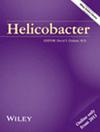Non-Helicobacter pylori Helicobacter (NHPH) is rarely detected in duodenal mucosa due to its preference for slightly acidic environments. Here, we report four cases of NHPH-infected gastritis with duodenal spiral bacilli, potentially NHPH, indicating the possibility of duodenal mucosal infection.
In every case, gastric mucosa showed endoscopic findings characteristic of NHPH-infected gastritis, and a mucosal biopsy was taken from the duodenal bulb; spiral bacilli were identified under microscopy using Giemsa staining. Case 1, a 46-year-old man, had diffuse spotty redness, mucosal edema, and multiple tiny erosions in the duodenal bulb, along with larger erosions in the second portion of the duodenum upon endoscopic examination. Histopathologically, moderate infiltration of mononuclear cells and neutrophils in the lamina propria and gastric epithelial metaplasia were observed. Case 2, a 54-year-old man, showed an elevated lesion, 1 cm in diameter, with multiple red spots and a few tiny erosions in the duodenal bulb. Histopathologically, mild inflammatory cell infiltration and gastric epithelial metaplasia were observed. In Case 3, a 52-year-old man, endoscopy revealed a flat elevated lesion, 7 mm in diameter, with multiple red spots and a few tiny erosions in the anterior wall of the duodenal bulb. Histopathologically, we observed moderate inflammatory cell infiltration in the gastric antrum and gastric epithelial metaplasia in the duodenal bulb. Case 4, a 40-year-old man, showed mild spotty redness in the duodenal bulb. Histopathologically, mild mononucleocyte infiltration and gastric epithelial metaplasia were observed. A single spiral bacillus was observed in Case 4 by microscopy. In all but Case 2, Helicobacter suis was identified in the gastric juice by polymerase chain reaction analysis.
Spiral bacilli resembling NHPH may infect the duodenal mucosa, particularly the bulb, causing inflammation. Gastric contents entering the duodenum may reduce the intraduodenal pH, promoting NHPH survival and proliferation.


